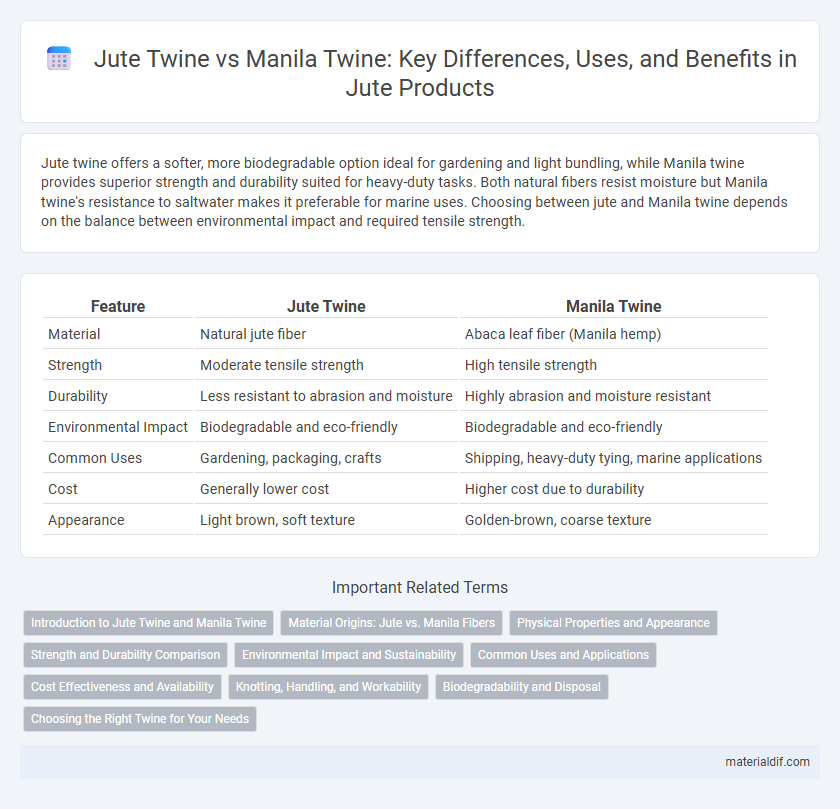Jute twine offers a softer, more biodegradable option ideal for gardening and light bundling, while Manila twine provides superior strength and durability suited for heavy-duty tasks. Both natural fibers resist moisture but Manila twine's resistance to saltwater makes it preferable for marine uses. Choosing between jute and Manila twine depends on the balance between environmental impact and required tensile strength.
Table of Comparison
| Feature | Jute Twine | Manila Twine |
|---|---|---|
| Material | Natural jute fiber | Abaca leaf fiber (Manila hemp) |
| Strength | Moderate tensile strength | High tensile strength |
| Durability | Less resistant to abrasion and moisture | Highly abrasion and moisture resistant |
| Environmental Impact | Biodegradable and eco-friendly | Biodegradable and eco-friendly |
| Common Uses | Gardening, packaging, crafts | Shipping, heavy-duty tying, marine applications |
| Cost | Generally lower cost | Higher cost due to durability |
| Appearance | Light brown, soft texture | Golden-brown, coarse texture |
Introduction to Jute Twine and Manila Twine
Jute twine, made from natural plant fibers of the jute plant, offers biodegradable and eco-friendly qualities ideal for gardening and packaging. Manila twine, derived from abaca fibers native to the Philippines, is known for its exceptional strength and durability, making it suitable for heavy-duty applications. Both types of twine provide sustainable alternatives to synthetic ropes, with jute favoring softness and flexibility, while manila excels in tensile strength.
Material Origins: Jute vs. Manila Fibers
Jute twine is derived from the soft, golden fibers of the jute plant primarily grown in Bangladesh and India, prized for its biodegradability and affordability. Manila twine originates from abaca leaves native to the Philippines, offering superior strength, resistance to saltwater, and durability. Both natural fibers serve distinct purposes, with jute favored for eco-friendly applications and manila preferred where durability and tensile strength are critical.
Physical Properties and Appearance
Jute twine is softer and more flexible with a natural golden-brown color, making it ideal for lightweight bundling and crafts requiring a rustic appearance. Manila twine, derived from abaca fibers, is stronger and more durable with a coarser texture and a pale yellow to tan hue, suitable for heavy-duty binding and outdoor use. The choice between jute and manila twine depends on the required tensile strength and aesthetic preference for natural fiber products.
Strength and Durability Comparison
Jute twine offers moderate tensile strength and biodegradability, making it suitable for light-duty packaging and gardening tasks, whereas Manila twine, derived from abaca fibers, provides superior tensile strength and higher resistance to abrasion and moisture. Manila twine maintains durability under harsh environmental conditions, outperforming jute in long-term outdoor applications. For heavy-duty uses and industrial packaging, Manila twine is preferred due to its robust fiber structure and increased longevity.
Environmental Impact and Sustainability
Jute twine is biodegradable and compostable, making it a highly sustainable option with a low environmental footprint compared to Manila twine, which is derived from abaca plants but often processed with chemical treatments. The cultivation of jute requires fewer pesticides and less water, contributing to reduced ecological impact, while Manila twine's production can involve deforestation and habitat disruption. Choosing jute twine supports renewable resource use and aligns with eco-friendly agricultural practices, promoting long-term environmental conservation.
Common Uses and Applications
Jute twine is commonly used for gardening, crafts, and packaging due to its biodegradable nature and soft texture, ideal for tying plants and creating decorative items. Manila twine, made from abaca fibers, excels in heavy-duty applications such as shipping, construction, and agricultural bundling because of its exceptional strength and resistance to moisture. Both twines serve distinct purposes where jute provides eco-friendly versatility and manila offers durability for demanding tasks.
Cost Effectiveness and Availability
Jute twine is generally more cost-effective than Manila twine due to its lower production costs and abundant availability in regions like India and Bangladesh, making it a budget-friendly option for packaging and gardening. Manila twine, derived from abaca fibers, is more expensive but offers superior strength and durability, which may justify its higher price in heavy-duty applications. Availability of jute twine is widespread globally, whereas manila twine is less common and often dependent on specific regional supply chains.
Knotting, Handling, and Workability
Jute twine offers superior knotting capabilities due to its natural fibers that grip tightly without slipping, making it ideal for secure bundling tasks. In comparison, Manila twine, while strong, tends to be stiffer and coarser, which can complicate handling and result in less flexible knotting performance. Jute twine's softer texture enhances workability, allowing for easier manipulation and faster tying in various agricultural and craft applications.
Biodegradability and Disposal
Jute twine offers superior biodegradability compared to Manila twine due to its natural cellulose fiber composition that decomposes quickly in soil and water environments. Manila twine, derived from abaca plant fibers, is also biodegradable but tends to break down slower and may retain residues longer in marine or agricultural settings. Proper disposal of jute twine can be managed through composting or natural degradation, minimizing environmental impact, whereas Manila twine requires longer periods for complete decomposition, affecting waste management strategies.
Choosing the Right Twine for Your Needs
Jute twine, made from natural vegetable fibers, offers excellent biodegradability and softness, making it ideal for gardening, crafting, and packaging delicate items. Manila twine, derived from abaca plant fibers, provides superior strength and resistance to abrasion and moisture, suited for heavy-duty tasks like shipping and construction. Selecting the right twine depends on balancing durability requirements with environmental impact and application specifics.
Jute Twine vs Manila Twine Infographic

 materialdif.com
materialdif.com